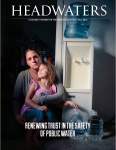 By Amy Conklin, the Barr Lake and Milton Reservoir Watershed Association
By Amy Conklin, the Barr Lake and Milton Reservoir Watershed Association
Have you ever taken a picnic or gone for a hike at one our local lakes only to find it a green, stinky mess because of all the algae? Did you think, ‘Why doesn’t someone do something about this?’ Well, they are.
Since 2002, the Barr Lake and Milton Reservoir Watershed Association (BMW) has been working to identify what causes the stinky algal blooms and find ways to prevent them.
What BMW found is that excessive nutrients coming from human activities are feeding the algae and creating the excessive blooms. This process is called cultural eutrophication. It means that the products of urban living, stormwater, wastewater and other runoff, act like fertilizer on a lawn and turn Barr Lake green.
At Barr Lake, one result of all the algal blooms is high pH (an alkaline condition) and low dissolved oxygen (DO). Like us, fish need oxygen. When the DO gets too low, fish get stressed and can die. We don’t want the majestic eagles or noisy osprey at Barr Lake to go hungry!
Barr Lake receives water that drains from the urban Denver metro area. In fact, about half of Colorado’s population lives in the BMW watershed. Very few know that the good folks at BMW are working hard to keep the water in Barr Lake and the Denver metro area clean.
One of the first questions BMW had to answer was how clean is clean? The levels of nutrients needed to keep the algal blooms at manageable levels, at levels where all the uses of the lake could occur, are laid out in laws and regulations. The answer to how clean is clean, what are acceptable levels of nutrients, has been well researched. That’s the good news. The bad news is that 90% of the nutrients getting into the lake need to be removed to achieve acceptable levels of nutrients.
BMW developed a multi-pronged approach to get the nutrients out of the water. They’re working with the publicly owned wastewater treatment plants to increase removal of nutrients from wastewater. They’re also working to clean the stormwater that runs down gutters into the stream and they’re working on ways to keep nutrients from re-entering the water column from the lake sediments.
The plan is already working with billions of $ being spent but it will take many years before the water is so clean that there aren’t stinky algae blooms. You can do your part:
- Fertilize your lawn ONLY with products that don’t contain Phosphorus.
- Pick up after your pet.
- Use a Commercial car wash.
- Keep grass clippings and leaves out of the gutter.
- Use a commercial company to change your oil.
With all of us working together, we can keep our water clean.
Listen to the recording of our April 2017 webinar presented by the Colorado Foundation for Water Education and offered in partnership with Colorado Water Congress with support from the Colorado Department of Public Health and Environment. to hear more of the BMW story. Read more about nutrients as nonpoint source pollution in the CFWE blog posts, The Runoff Conundrum, Preventing Water Pollution Starts in Your Backyard, and In Bloom.
 Find further coverage on these topics in the Public Health Issue of Headwaters Magazine and learn more about water quality in CFWE’s Citizen’s Guide to Colorado Water Quality Protection. Then stay posted for new content on data in the upcoming summer 2017 issue of Headwaters.
Find further coverage on these topics in the Public Health Issue of Headwaters Magazine and learn more about water quality in CFWE’s Citizen’s Guide to Colorado Water Quality Protection. Then stay posted for new content on data in the upcoming summer 2017 issue of Headwaters.
Not a Headwaters subscriber? Visit yourwatercolorado.org for the digital version. Headwaters is the flagship publication of the Colorado Foundation for Water Education and covers current events, trends and opportunities in Colorado water.
 Amy Conklin is proud to offer her services for finding solutions to water issues. With a Masters in Water Resources Management and experience in the public and private sectors, she brings diverse groups together to solve water issues. Recently, Amy developed a 12 minute video describing the process for developing water messages. It can be found on YouTube and www.barr-milton.org. Amy is currently working as the coordinator of the Barr Lake and Milton Reservoir Watershed Association and is also working with the Colorado Stormwater Council to develop a Statewide Water Quality Education Campaign. You can learn more about Amy at LinkedIn, http://www.linkedin.com/in/amysconklin/
Amy Conklin is proud to offer her services for finding solutions to water issues. With a Masters in Water Resources Management and experience in the public and private sectors, she brings diverse groups together to solve water issues. Recently, Amy developed a 12 minute video describing the process for developing water messages. It can be found on YouTube and www.barr-milton.org. Amy is currently working as the coordinator of the Barr Lake and Milton Reservoir Watershed Association and is also working with the Colorado Stormwater Council to develop a Statewide Water Quality Education Campaign. You can learn more about Amy at LinkedIn, http://www.linkedin.com/in/amysconklin/

 Print
Print
Reblogged this on Coyote Gulch.